Due to the US Government shutdown, the Smithsonian is temporarily closed. The Global Volcanism Program website will remain available but will not be monitored or updated. Status updates will be available on the Smithsonian homepage.


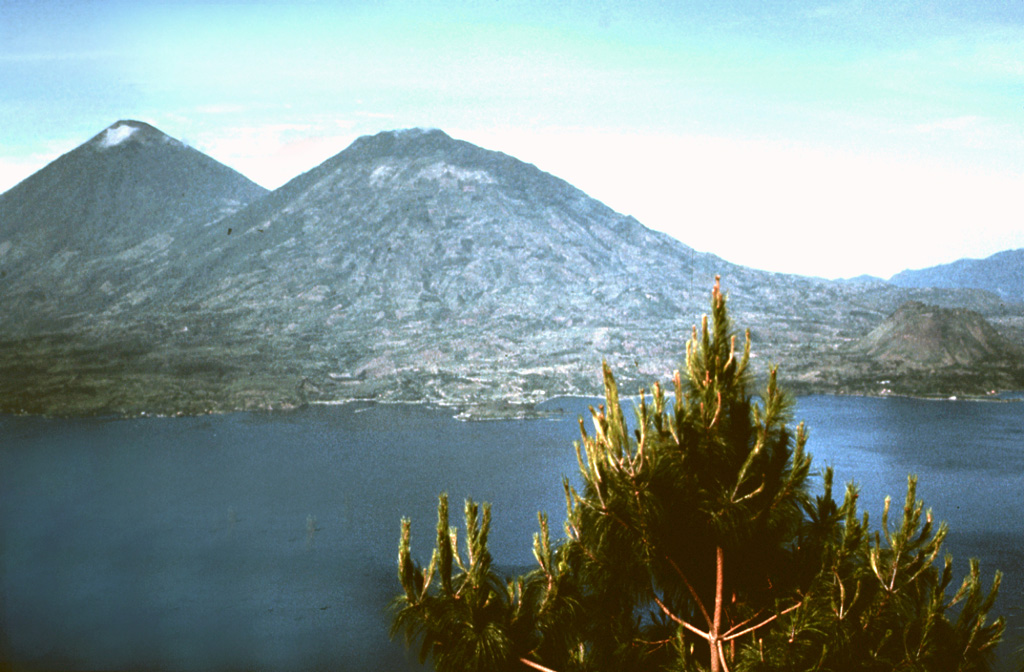
A landslide on the outer flanks of Tolimán volcano passed through and buried portions of a mountain village at 0418 on 23 April. Regional authorities blamed steep slopes, wet soils, and minor tremors. The disaster struck the village of Chichicaste, which lies along the volcanic front ~300 km W of the capital, Guatemala City. Tolimán and the area stricken sit on the S side of Lake Atitlán, the 18 x 12 km lake filling the depression of Guatemala's famous Atitlán caldera.
As of the afternoon of 23 April, the Guatemalan agency CONRED reported 200 people evacuated, 20 missing, and 6 confirmed dead. Known damage to infrastructure included 40 homes at risk, another 12 with severe damage, and 6 destroyed. The village and environs had been specifically mentioned as vulnerable to landslide hazards in a government report issued in September 2002 following a similar disaster then. Mudslides in highland areas are common during the wet season, an interval that often occurs during late March through September.
[Correction: the landslide recorded in April 2003 did not occur on the flanks of Toliman as erroneaously reported; instead the landslide occurred in Chim, an area about 75 NW of the volcano.]
Sources: Instituto Nacional de Sismologia, Vulcanologia, Meteorologia, e Hidrologia (INSIVUMEH), Coordinadora Nacional para la Reducción de Desastres (CONRED)
2003: April
A landslide on the outer flanks of Tolimán volcano passed through and buried portions of a mountain village at 0418 on 23 April. Regional authorities blamed steep slopes, wet soils, and minor tremors. The disaster struck the village of Chichicaste, which lies along the volcanic front ~300 km W of the capital, Guatemala City. Tolimán and the area stricken sit on the S side of Lake Atitlán, the 18 x 12 km lake filling the depression of Guatemala's famous Atitlán caldera.
As of the afternoon of 23 April, the Guatemalan agency CONRED reported 200 people evacuated, 20 missing, and 6 confirmed dead. Known damage to infrastructure included 40 homes at risk, another 12 with severe damage, and 6 destroyed. The village and environs had been specifically mentioned as vulnerable to landslide hazards in a government report issued in September 2002 following a similar disaster then. Mudslides in highland areas are common during the wet season, an interval that often occurs during late March through September.
[Correction: the landslide recorded in April 2003 did not occur on the flanks of Toliman as erroneaously reported; instead the landslide occurred in Chim, an area about 75 NW of the volcano.]
Sources: Instituto Nacional de Sismologia, Vulcanologia, Meteorologia, e Hidrologia (INSIVUMEH); Coordinadora Nacional para la Reducción de Desastres (CONRED)
The Global Volcanism Program has no Bulletin Reports available for Tolimán.
|
|
||||||||||||||||||||||||||
The Global Volcanism Program is not aware of any Holocene eruptions from Tolimán. If this volcano has had large eruptions (VEI >= 4) prior to 12,000 years ago, information might be found on the Tolimán page in the LaMEVE (Large Magnitude Explosive Volcanic Eruptions) database, a part of the Volcano Global Risk Identification and Analysis Project (VOGRIPA).
This compilation of synonyms and subsidiary features may not be comprehensive. Features are organized into four major categories: Cones, Craters, Domes, and Thermal Features. Synonyms of features appear indented below the primary name. In some cases additional feature type, elevation, or location details are provided.
Synonyms |
||||
| Northern Atitlán | Casuela Juyu | San Lucas | ||||
Cones |
||||
| Feature Name | Feature Type | Elevation | Latitude | Longitude |
| Central Atitlán | Cone | 3134 m | 14° 36' 40.00" N | 91° 11' 10.00" W |
Domes |
||||
| Feature Name | Feature Type | Elevation | Latitude | Longitude |
| Oro, Cerro de | Dome | 1892 m | 14° 39' 50.00" N | 91° 10' 41.00" W |
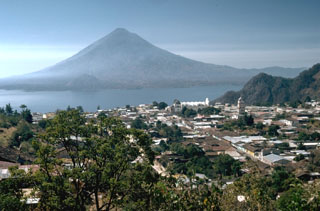 Atitlán and Tolimán volcanoes rise above Lake Atitlán in this view from the town of Sololá north of the lake. Atitlán is the taller of the two and forms the skyline immediately behind and to the left of Tolimán. The Cerro de flank lava dome immediately above the lakeshore to the lower left of the summit erupted within the past few thousand years. The two volcanoes were constructed over the buried rims of two Miocene-Pleistocene Atitlán calderas.
Atitlán and Tolimán volcanoes rise above Lake Atitlán in this view from the town of Sololá north of the lake. Atitlán is the taller of the two and forms the skyline immediately behind and to the left of Tolimán. The Cerro de flank lava dome immediately above the lakeshore to the lower left of the summit erupted within the past few thousand years. The two volcanoes were constructed over the buried rims of two Miocene-Pleistocene Atitlán calderas.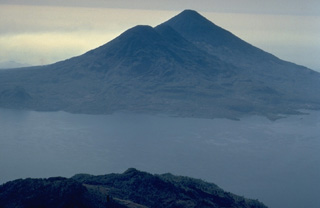 The twin volcanoes of Tolimán and Atitlán rise above the southern shores of Lake Atitlán in this view from the NNW. The surface of Tolimán (left) is draped by prominent thick lava flows. Many of the flows were erupted from vents on the volcano's flanks and form an irregular shoreline on the south side of Lake Atitlán. A lava flow from the parasitic lava dome of Cerro de Oro on the north flank entered Lake Atitlán and is less than a few thousand years old. No historical eruptions are known from Tolimán.
The twin volcanoes of Tolimán and Atitlán rise above the southern shores of Lake Atitlán in this view from the NNW. The surface of Tolimán (left) is draped by prominent thick lava flows. Many of the flows were erupted from vents on the volcano's flanks and form an irregular shoreline on the south side of Lake Atitlán. A lava flow from the parasitic lava dome of Cerro de Oro on the north flank entered Lake Atitlán and is less than a few thousand years old. No historical eruptions are known from Tolimán.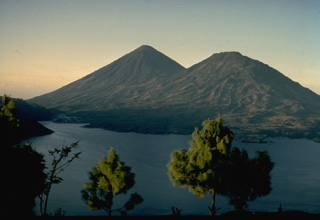 Atitlán (left) and Tolimán (right) are twin stratovolcanoes on the shores of Lake Atitlán, one of the scenic highlights of Guatemala. The historically active Atitlán is younger than Tolimán, although their activity overlaps. The surface of Tolimán is draped by prominent thick lava flows, in contrast to the extensive pyroclastic cover on Atitlán. Tolimán lava flows, erupted from both summit and flank vents, have produced a pronounced embayment with an irregular shoreline that extends into the lake. This view is from the NE on the rim of Atitlán caldera.
Atitlán (left) and Tolimán (right) are twin stratovolcanoes on the shores of Lake Atitlán, one of the scenic highlights of Guatemala. The historically active Atitlán is younger than Tolimán, although their activity overlaps. The surface of Tolimán is draped by prominent thick lava flows, in contrast to the extensive pyroclastic cover on Atitlán. Tolimán lava flows, erupted from both summit and flank vents, have produced a pronounced embayment with an irregular shoreline that extends into the lake. This view is from the NE on the rim of Atitlán caldera.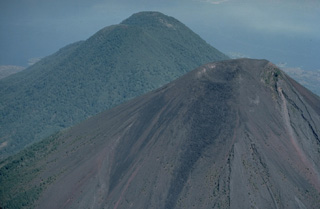 Atitlán (foreground) and Tolimán are twin volcanoes located immediately south of Lake Atitlán (background). Tolimán was constructed on the buried rim of the Atitlán II caldera, whereas Volcán Atitlán was built 4 km south over the rim of the Atitlán III caldera. Atitlán, whose summit area remains unvegetated, has been active in historical time. Tolimán has not had historical eruptions, but has erupted within the past 1000 years.
Atitlán (foreground) and Tolimán are twin volcanoes located immediately south of Lake Atitlán (background). Tolimán was constructed on the buried rim of the Atitlán II caldera, whereas Volcán Atitlán was built 4 km south over the rim of the Atitlán III caldera. Atitlán, whose summit area remains unvegetated, has been active in historical time. Tolimán has not had historical eruptions, but has erupted within the past 1000 years.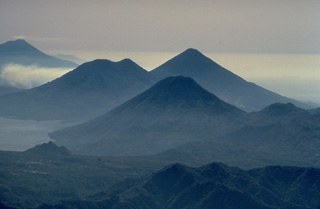 The twin volcanoes of Tolimán (left) and Atitlán (right) on the center skyline, along with San Pedro volcano in the foreground, rise above the southern shores of Lake Atitlán. This aerial view looking along the chain of stratovolcanoes stretching across Guatemala, also shows Fuego volcano at the upper left. The double-peaked Tolimán is somewhat older than the conical Atitlán volcano to its south.
The twin volcanoes of Tolimán (left) and Atitlán (right) on the center skyline, along with San Pedro volcano in the foreground, rise above the southern shores of Lake Atitlán. This aerial view looking along the chain of stratovolcanoes stretching across Guatemala, also shows Fuego volcano at the upper left. The double-peaked Tolimán is somewhat older than the conical Atitlán volcano to its south.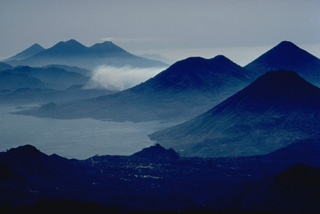 This dramatic photo looking SE down the axis of a chain of volcanoes extending across Guatemala shows six Quaternary volcanoes and one large caldera. Beginning in the right foreground are three volcanoes, San Pedro, the conical Atitlán, and Tolimán, that are constructed on the southern shore of Lake Atitlán, which fills a large Pleistocene caldera. The three volcanoes in the distance are, from left to right, Agua, Acatenango, and Fuego. Tolimán-Atitlán and Acatenango-Fuego are paired volcanoes along N-S lines.
This dramatic photo looking SE down the axis of a chain of volcanoes extending across Guatemala shows six Quaternary volcanoes and one large caldera. Beginning in the right foreground are three volcanoes, San Pedro, the conical Atitlán, and Tolimán, that are constructed on the southern shore of Lake Atitlán, which fills a large Pleistocene caldera. The three volcanoes in the distance are, from left to right, Agua, Acatenango, and Fuego. Tolimán-Atitlán and Acatenango-Fuego are paired volcanoes along N-S lines.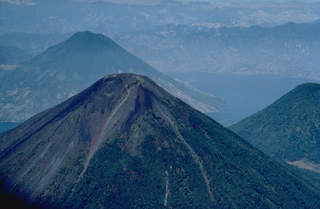 Volcán Atitlán, seen here from the SE with San Pedro volcano behind it and Tolimán volcano to its left, is a conical stratovolcano that rises to 3535 m south of Lake Atitlán (right). The historically active Atitlán is younger than Tolimán, although their activity overlaps. The northern side of the volcano is wooded to near the summit, whereas the upper 1000 m of the southern slopes, seen here, are unvegetated. Predominatley explosive eruptions have been recorded from Volcán Atitlán since the 15th century.
Volcán Atitlán, seen here from the SE with San Pedro volcano behind it and Tolimán volcano to its left, is a conical stratovolcano that rises to 3535 m south of Lake Atitlán (right). The historically active Atitlán is younger than Tolimán, although their activity overlaps. The northern side of the volcano is wooded to near the summit, whereas the upper 1000 m of the southern slopes, seen here, are unvegetated. Predominatley explosive eruptions have been recorded from Volcán Atitlán since the 15th century.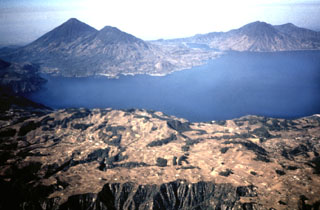 Three stratovolcanoes fill the southern half of Atitlán caldera in this view from the NE. Atitlán caldera formed during three major explosive eruptions from the Miocene to late Pleistocene. Atitlán volcano (far left) was constructed above the southern rim of the youngest caldera, Atitlán III, whose low southern rim is visible on the center horizon beyond narrow Santiago bay. Tolimán (right of Atitlán) and San Pedro (far right) overlie the rim of Atitlán II. The buried rim of Atitlán I lies below the shoreline of Tolimán.
Three stratovolcanoes fill the southern half of Atitlán caldera in this view from the NE. Atitlán caldera formed during three major explosive eruptions from the Miocene to late Pleistocene. Atitlán volcano (far left) was constructed above the southern rim of the youngest caldera, Atitlán III, whose low southern rim is visible on the center horizon beyond narrow Santiago bay. Tolimán (right of Atitlán) and San Pedro (far right) overlie the rim of Atitlán II. The buried rim of Atitlán I lies below the shoreline of Tolimán.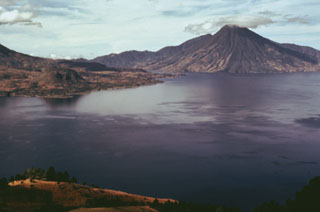 Volcán San Pedro (upper right) is the oldest of three stratovolcanoes constructed within Atitlán caldera. The furrowed slopes of the volcano contrast with the less eroded flanks of the both Atitlán and Tolimán volcanoes. Cerro de Oro, the small lava dome just beyond the shore of Lake Atitlán to the left, is a flank dome of Tolimán. Young lava flows from Tolimán descend into the lake and form part of its southern shore in this view from the west.
Volcán San Pedro (upper right) is the oldest of three stratovolcanoes constructed within Atitlán caldera. The furrowed slopes of the volcano contrast with the less eroded flanks of the both Atitlán and Tolimán volcanoes. Cerro de Oro, the small lava dome just beyond the shore of Lake Atitlán to the left, is a flank dome of Tolimán. Young lava flows from Tolimán descend into the lake and form part of its southern shore in this view from the west.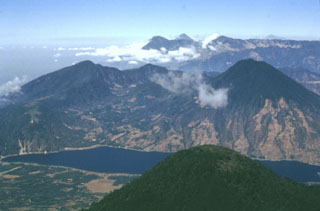 The rounded peak in the foreground is Tolimán volcano. The older post-caldera San Pedro volcano is across Santiago Bay to the right. In the distance are the peaks of Santo Tomás (left) and Santa María (right). Tajumulco volcano is the peak on the far-right horizon. The Guatemalan volcanic front rises more than 3,500 m above the hazy Pacific coastal plain to the upper left.
The rounded peak in the foreground is Tolimán volcano. The older post-caldera San Pedro volcano is across Santiago Bay to the right. In the distance are the peaks of Santo Tomás (left) and Santa María (right). Tajumulco volcano is the peak on the far-right horizon. The Guatemalan volcanic front rises more than 3,500 m above the hazy Pacific coastal plain to the upper left. Volcán Tolimán (center) towers above the south shore of scenic Lake Atitlán. Tolimán and the adjacent Atitlán (upper left) were constructed within the Pleistocene Atitlán III caldera, near its inferred southern margin. In contrast to the tephra-covered surface of Volcán Atitlán, the surface of Tolimán is dominated by thick lava flows. The recent eruptions of Tolimán were primarily effusive eruptions from flank vents. The resulting lava flows extend into the lake and produce the irregular shoreline.
Volcán Tolimán (center) towers above the south shore of scenic Lake Atitlán. Tolimán and the adjacent Atitlán (upper left) were constructed within the Pleistocene Atitlán III caldera, near its inferred southern margin. In contrast to the tephra-covered surface of Volcán Atitlán, the surface of Tolimán is dominated by thick lava flows. The recent eruptions of Tolimán were primarily effusive eruptions from flank vents. The resulting lava flows extend into the lake and produce the irregular shoreline.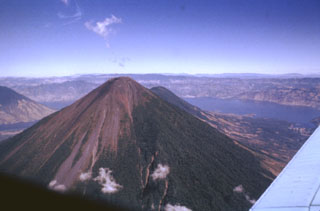 Volcán Atitlán directly overlies the inferred margin of the Pleistocene Atitlán III caldera, whose northern rim lies across Lake Atitlán. The Atitlán stratovolcano is adjacent to Tolimán to its north (seen just to the right of Atitlán's summit). The historically active Atitlán is younger than Tolimán, although their earlier activity overlapped. Atitlán’s surface is composed of tephra, reflecting its predominantly explosive eruptions that have been recorded since the 15th century.
Volcán Atitlán directly overlies the inferred margin of the Pleistocene Atitlán III caldera, whose northern rim lies across Lake Atitlán. The Atitlán stratovolcano is adjacent to Tolimán to its north (seen just to the right of Atitlán's summit). The historically active Atitlán is younger than Tolimán, although their earlier activity overlapped. Atitlán’s surface is composed of tephra, reflecting its predominantly explosive eruptions that have been recorded since the 15th century.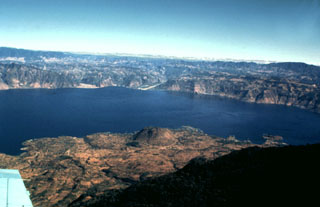 Lake Atitlán fills the northern half of the Atitlán III caldera, which formed about 84,000 years ago following eruption of the Los Chocoyos Ash. The 18-km-long caldera lake is seen here from the south, with the flanks of the post-caldera Tolimán volcano in the foreground. The relatively flat lake floor is 300 m below the water surface, and caldera walls rise to about 1 km above the lake.
Lake Atitlán fills the northern half of the Atitlán III caldera, which formed about 84,000 years ago following eruption of the Los Chocoyos Ash. The 18-km-long caldera lake is seen here from the south, with the flanks of the post-caldera Tolimán volcano in the foreground. The relatively flat lake floor is 300 m below the water surface, and caldera walls rise to about 1 km above the lake. 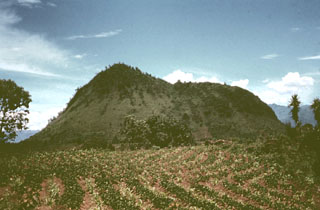 Cerro de Oro is a lava dome that was constructed on the northern flank of Tolimán, near the southern shoreline of Lake Atitlán. Lava flows from Cerro de Oro extend into the lake and may be as young as a few thousand years. The dome's name (which means Hill of Gold) reflects local belief that it contains buried treasure.
Cerro de Oro is a lava dome that was constructed on the northern flank of Tolimán, near the southern shoreline of Lake Atitlán. Lava flows from Cerro de Oro extend into the lake and may be as young as a few thousand years. The dome's name (which means Hill of Gold) reflects local belief that it contains buried treasure.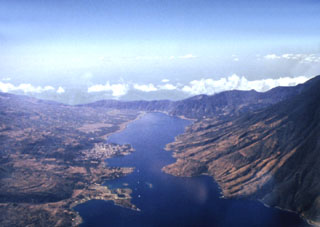 Santiago Bay in Lake Atitlán is the result of encroachment by the flanks of three post-caldera volcanoes into the lake. The narrow channel extends about 8 km to the low southern caldera wall and is about 1 km wide. To the right are the San Pedro flanks, the oldest of the post-caldera stratovolcanoes. Contrasting eruptive styles produced the irregular shoreline in the left foreground consisting of lava flows from Tolimán and the smoother shoreline to the right, formed by pyroclastic deposits from Atitlán.
Santiago Bay in Lake Atitlán is the result of encroachment by the flanks of three post-caldera volcanoes into the lake. The narrow channel extends about 8 km to the low southern caldera wall and is about 1 km wide. To the right are the San Pedro flanks, the oldest of the post-caldera stratovolcanoes. Contrasting eruptive styles produced the irregular shoreline in the left foreground consisting of lava flows from Tolimán and the smoother shoreline to the right, formed by pyroclastic deposits from Atitlán.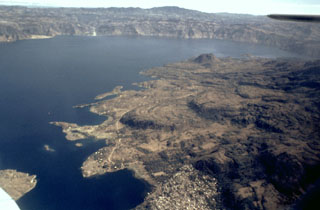 Lobate lava flows from Tolimán volcano form the irregular shore jutting into Lake Atitlán. The Cerro de Oro cone is on the near shore to the upper right, and the NE wall of Atitlán caldera rises about 1 km above the far side of the lake. The town of Santiago Atitlán (foreground) lies near the mouth of Santiago Bay. The buried margin of Atitlán I caldera, the first of three Miocene-Pleistocene calderas at Atitlán, lies approximately below Cerro de Oro; the boundary of Atitlán II caldera lies just below the bottom of the photo.
Lobate lava flows from Tolimán volcano form the irregular shore jutting into Lake Atitlán. The Cerro de Oro cone is on the near shore to the upper right, and the NE wall of Atitlán caldera rises about 1 km above the far side of the lake. The town of Santiago Atitlán (foreground) lies near the mouth of Santiago Bay. The buried margin of Atitlán I caldera, the first of three Miocene-Pleistocene calderas at Atitlán, lies approximately below Cerro de Oro; the boundary of Atitlán II caldera lies just below the bottom of the photo.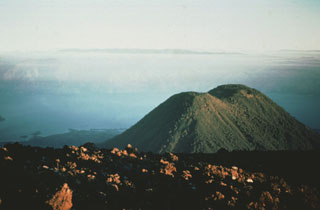 Tolimán volcano is 4 km away beyond the summit of Atitlán. Atitlán was constructed over the approximate rim of the Atitlán III caldera, whereas Tolimán was built over the margin of Atitlán II caldera. The irregular Lake Atitlán shoreline to the left is formed by lava flows from Tolimán. The far Atitlán III caldera rim can be faintly seen across the lake. The two post-caldera cones have dramatically different eruptive styles, with lava flows dominating at Tolimán and pyroclastic eruptions at Atitlán.
Tolimán volcano is 4 km away beyond the summit of Atitlán. Atitlán was constructed over the approximate rim of the Atitlán III caldera, whereas Tolimán was built over the margin of Atitlán II caldera. The irregular Lake Atitlán shoreline to the left is formed by lava flows from Tolimán. The far Atitlán III caldera rim can be faintly seen across the lake. The two post-caldera cones have dramatically different eruptive styles, with lava flows dominating at Tolimán and pyroclastic eruptions at Atitlán. 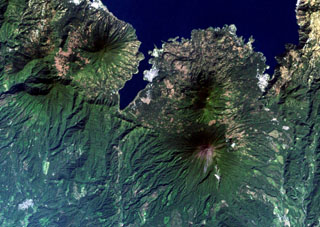 The 6-km-long, dagger-like Santiago Bay on Lake Atitlán is constrained by lava flows from San Pedro (upper left) and Tolimán (right-center) volcanoes. Young lava flows entering the lake, in particular those from Tolimán, have created a very irregular shoreline. The unvegetated summit of Atitlán volcano, the youngest post-caldera stratovolcano, lies south of Tolimán. Part of the southern margin of the Atitlán III caldera, which lies below the summit of Atitlán volcano, is offset along faults just south of the tip of Santiago Bay.
The 6-km-long, dagger-like Santiago Bay on Lake Atitlán is constrained by lava flows from San Pedro (upper left) and Tolimán (right-center) volcanoes. Young lava flows entering the lake, in particular those from Tolimán, have created a very irregular shoreline. The unvegetated summit of Atitlán volcano, the youngest post-caldera stratovolcano, lies south of Tolimán. Part of the southern margin of the Atitlán III caldera, which lies below the summit of Atitlán volcano, is offset along faults just south of the tip of Santiago Bay.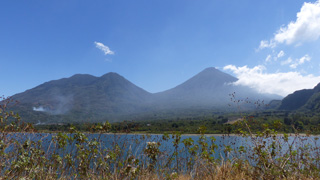 This 2018 view of Volcán Tolimán (left) and Volcán Atitlán (right) is from the shores of Lake Atitlan opposite the town of Santiago Atitlan (just out of view to the left). The cones formed along the southern rim of the Atitlán III caldera with the lake in the foreground filling the northern area.
This 2018 view of Volcán Tolimán (left) and Volcán Atitlán (right) is from the shores of Lake Atitlan opposite the town of Santiago Atitlan (just out of view to the left). The cones formed along the southern rim of the Atitlán III caldera with the lake in the foreground filling the northern area.There are no samples for Tolimán in the Smithsonian's NMNH Department of Mineral Sciences Rock and Ore collection.
| Copernicus Browser | The Copernicus Browser replaced the Sentinel Hub Playground browser in 2023, to provide access to Earth observation archives from the Copernicus Data Space Ecosystem, the main distribution platform for data from the EU Copernicus missions. |
| MIROVA | Middle InfraRed Observation of Volcanic Activity (MIROVA) is a near real time volcanic hot-spot detection system based on the analysis of MODIS (Moderate Resolution Imaging Spectroradiometer) data. In particular, MIROVA uses the Middle InfraRed Radiation (MIR), measured over target volcanoes, in order to detect, locate and measure the heat radiation sourced from volcanic activity. |
| MODVOLC Thermal Alerts | Using infrared satellite Moderate Resolution Imaging Spectroradiometer (MODIS) data, scientists at the Hawai'i Institute of Geophysics and Planetology, University of Hawai'i, developed an automated system called MODVOLC to map thermal hot-spots in near real time. For each MODIS image, the algorithm automatically scans each 1 km pixel within it to check for high-temperature hot-spots. When one is found the date, time, location, and intensity are recorded. MODIS looks at every square km of the Earth every 48 hours, once during the day and once during the night, and the presence of two MODIS sensors in space allows at least four hot-spot observations every two days. Each day updated global maps are compiled to display the locations of all hot spots detected in the previous 24 hours. There is a drop-down list with volcano names which allow users to 'zoom-in' and examine the distribution of hot-spots at a variety of spatial scales. |
|
WOVOdat
Single Volcano View Temporal Evolution of Unrest Side by Side Volcanoes |
WOVOdat is a database of volcanic unrest; instrumentally and visually recorded changes in seismicity, ground deformation, gas emission, and other parameters from their normal baselines. It is sponsored by the World Organization of Volcano Observatories (WOVO) and presently hosted at the Earth Observatory of Singapore.
GVMID Data on Volcano Monitoring Infrastructure The Global Volcano Monitoring Infrastructure Database GVMID, is aimed at documenting and improving capabilities of volcano monitoring from the ground and space. GVMID should provide a snapshot and baseline view of the techniques and instrumentation that are in place at various volcanoes, which can be use by volcano observatories as reference to setup new monitoring system or improving networks at a specific volcano. These data will allow identification of what monitoring gaps exist, which can be then targeted by remote sensing infrastructure and future instrument deployments. |
| Volcanic Hazard Maps | The IAVCEI Commission on Volcanic Hazards and Risk has a Volcanic Hazard Maps database designed to serve as a resource for hazard mappers (or other interested parties) to explore how common issues in hazard map development have been addressed at different volcanoes, in different countries, for different hazards, and for different intended audiences. In addition to the comprehensive, searchable Volcanic Hazard Maps Database, this website contains information about diversity of volcanic hazard maps, illustrated using examples from the database. This site is for educational purposes related to volcanic hazard maps. Hazard maps found on this website should not be used for emergency purposes. For the most recent, official hazard map for a particular volcano, please seek out the proper institutional authorities on the matter. |
| IRIS seismic stations/networks | Incorporated Research Institutions for Seismology (IRIS) Data Services map showing the location of seismic stations from all available networks (permanent or temporary) within a radius of 0.18° (about 20 km at mid-latitudes) from the given location of Tolimán. Users can customize a variety of filters and options in the left panel. Note that if there are no stations are known the map will default to show the entire world with a "No data matched request" error notice. |
| UNAVCO GPS/GNSS stations | Geodetic Data Services map from UNAVCO showing the location of GPS/GNSS stations from all available networks (permanent or temporary) within a radius of 20 km from the given location of Tolimán. Users can customize the data search based on station or network names, location, and time window. Requires Adobe Flash Player. |
| DECADE Data | The DECADE portal, still in the developmental stage, serves as an example of the proposed interoperability between The Smithsonian Institution's Global Volcanism Program, the Mapping Gas Emissions (MaGa) Database, and the EarthChem Geochemical Portal. The Deep Earth Carbon Degassing (DECADE) initiative seeks to use new and established technologies to determine accurate global fluxes of volcanic CO2 to the atmosphere, but installing CO2 monitoring networks on 20 of the world's 150 most actively degassing volcanoes. The group uses related laboratory-based studies (direct gas sampling and analysis, melt inclusions) to provide new data for direct degassing of deep earth carbon to the atmosphere. |
| Large Eruptions of Tolimán | Information about large Quaternary eruptions (VEI >= 4) is cataloged in the Large Magnitude Explosive Volcanic Eruptions (LaMEVE) database of the Volcano Global Risk Identification and Analysis Project (VOGRIPA). |
| EarthChem | EarthChem develops and maintains databases, software, and services that support the preservation, discovery, access and analysis of geochemical data, and facilitate their integration with the broad array of other available earth science parameters. EarthChem is operated by a joint team of disciplinary scientists, data scientists, data managers and information technology developers who are part of the NSF-funded data facility Integrated Earth Data Applications (IEDA). IEDA is a collaborative effort of EarthChem and the Marine Geoscience Data System (MGDS). |